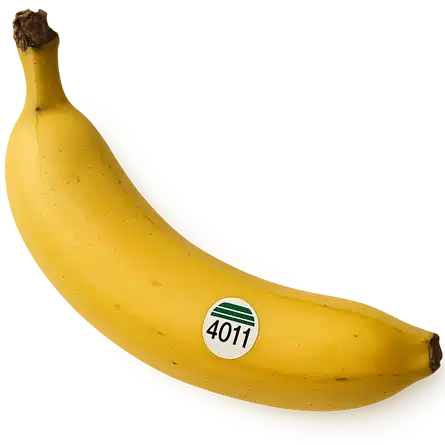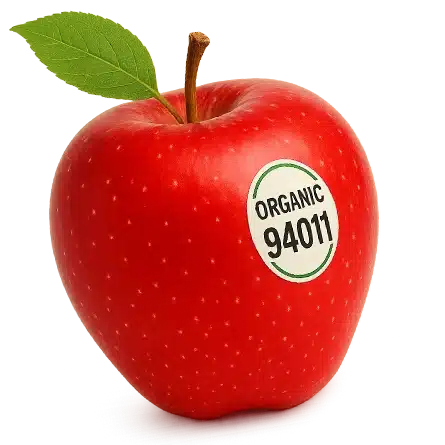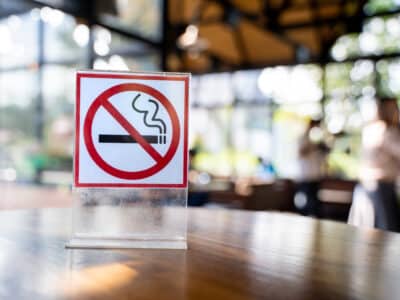4011 on Bananas? What Fruit Sticker Numbers Actually Mean
The number 4011 on bananas means you’re looking at a standard, conventionally grown Cavendish banana. That little sticker tells grocery stores (and you) what the fruit is, how it was grown, and how much it costs.
It’s part of the international PLU code system that makes produce checkout possible—and yes, there’s a real system behind it. If you’re selling produce, having the right produce labels can make your process a lot smoother.
So, What’s a PLU Code—Really?
PLU stands for Price Look-Up. Think of it as a fruit’s social security number. These codes are assigned by the International Federation for Produce Standards (IFPS), and they do more than just make cashiers’ lives easier.
Here’s how the numbers break down:
- 4-digit codes (like 4011): Conventionally grown produce
- 5-digit codes starting with 9: Organically grown
- 5-digit codes starting with 8: Genetically modified (though this one is rarely used)
Fun fact: There are over 1,400 active PLU codes in the IFPS database. That’s a lot of apples and avocados.
What Does 4011 Mean on a Banana?
The number 4011 has become the iconic code for bananas in grocery stores across the U.S. and beyond. Here’s the breakdown:
- Fruit type: Banana
- Variety: Cavendish (the yellow banana you probably grew up with)
- Grown: Conventionally (aka not organic)
If your banana says 94011, congrats—you’ve got the organic version. Same fruit, different farming.
Want to impress your kids at breakfast? Now you can decode their banana.

Why Do Fruits Even Have Stickers?
They may seem annoying when you’re trying to make a smoothie, but fruit stickers are actually power players behind the scenes. These tiny labels:
- Speed up checkout: No need to type in “green apple, not Granny Smith, the other one…”
- Keep pricing accurate: Helps prevent that $5 dragon fruit from being rung up as a 30-cent apple
- Support traceability: Important for recalls, shipping records, and inventory tracking
- Tell your story: Some farms even add QR codes to share their growing methods or sustainability info
And let’s be honest, some kids love collecting them. Banana sticker collage on the fridge, anyone?
Who Actually Uses These Labels?
Pretty much everyone along the food chain (pun fully intended):
- Growers: Mark produce before it leaves the farm
- Distributors: Sort, package, and track inventory
- Retailers: Keep checkout lines moving and stock rotating
- Restaurants: Label back-of-house produce bins or prep stations
- Farmers market vendors: Add price clarity without bulky signage
It’s not just about logistics. A well-placed sticker can even help small farms stand out at the booth.
Why Sticker Accuracy Matters
Whether you’re a grower, a grocer, or someone prepping for a local farmers market, understanding PLU codes shows your care for traceability, transparency, and customer trust. Even something as small as a sticker reflects food safety standards, pricing integrity, and labeling compliance, core practices backed by decades of industry use.
For example, the IFPS, a global organization of produce professionals, has set the standard for PLU codes since 1990. Many retailers require accurate PLU labeling to meet audit standards, and producers who follow these systems reduce checkout errors and increase efficiency.
Wait, Are Fruit Stickers Edible?
Not quite. PLU stickers are made with food-safe materials like thin plastic or waxy paper, and the adhesive is FDA-approved for indirect food contact. But “food-safe” isn’t the same as “food.” So if you accidentally eat one? You’ll probably be fine. But it’s better to peel it off first—your stomach will thank you.
More PLU Codes You Might Recognize
Here’s a fun challenge: Start checking your produce drawer. You might see these in rotation:
- 4131 – Fuji Apple (conventional)
- 94080 – Organic Avocado
- 4030 – Kiwi (conventional)
- 94232 – Organic Red Grapes
You can even make it a farmers market scavenger hunt. Bonus points if you spot a code starting with 8, those are unicorns.
How Produce Stickers Help Farmers and Markets
Beyond pricing, these labels help small sellers compete with big-box grocery stores. With the right produce labels:
- Small farms look more professional
- Shoppers can tell what’s organic or local at a glance
- Products meet health department and packaging rules
During National Farmers Market Week, it’s a great time to celebrate all the quiet helpers that keep fresh food moving—including these tiny, sticky powerhouses.
Quick Recap: What That Little Sticker Really Tells You
If you remember nothing else, take this with you:
- 4011 = conventional Cavendish banana
- 94011 = organic banana
- 4-digit codes = conventionally grown
- Codes starting with 9 = organic
- Stickers = vital tools for pricing, traceability, and compliance
They’re small, but they play a big role in how your fruit gets from farm to fridge.

Want Custom or Preprinted Produce Labels?
If you’re selling produce, whether it’s five crates or 5,000 pounds, you need labels that work as hard as you do. Our produce labels are ready to use, food-safe, and easy to apply. Perfect for market prep, wholesale packaging, or simply making your brand a little more sticky (in a good way).
4011 on Bananas FAQs
It’s the global PLU code for a conventionally grown Cavendish banana—the most common banana on grocery shelves.
They’re PLU (Price Look-Up) codes that help identify produce type, variety, and farming method for pricing and inventory.
Look for a 5-digit code starting with “9”, like 94011. That’s organic.
Not really. They’re made from food-safe materials but aren’t meant to be digested. Peel before you snack.
They help with pricing, organization, and professionalism—plus they’re often required for packaging and compliance.
Absolutely. Plenty of suppliers (like us!) offer food-safe, customizable produce labels that stick well and look great.







